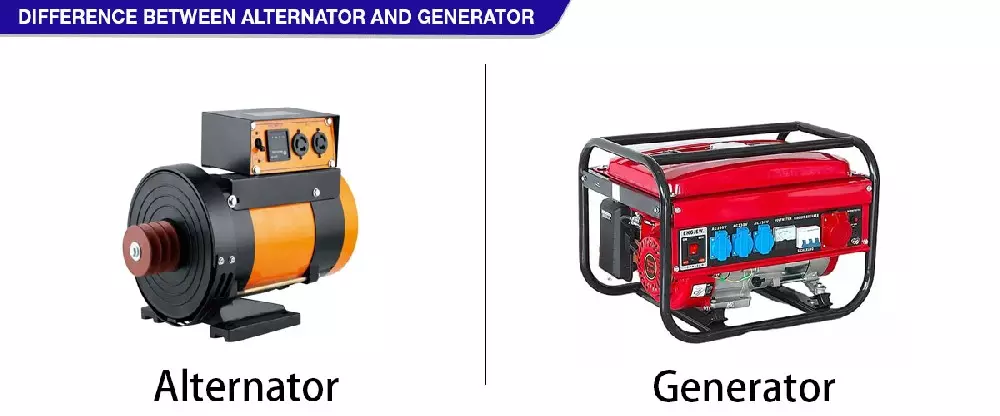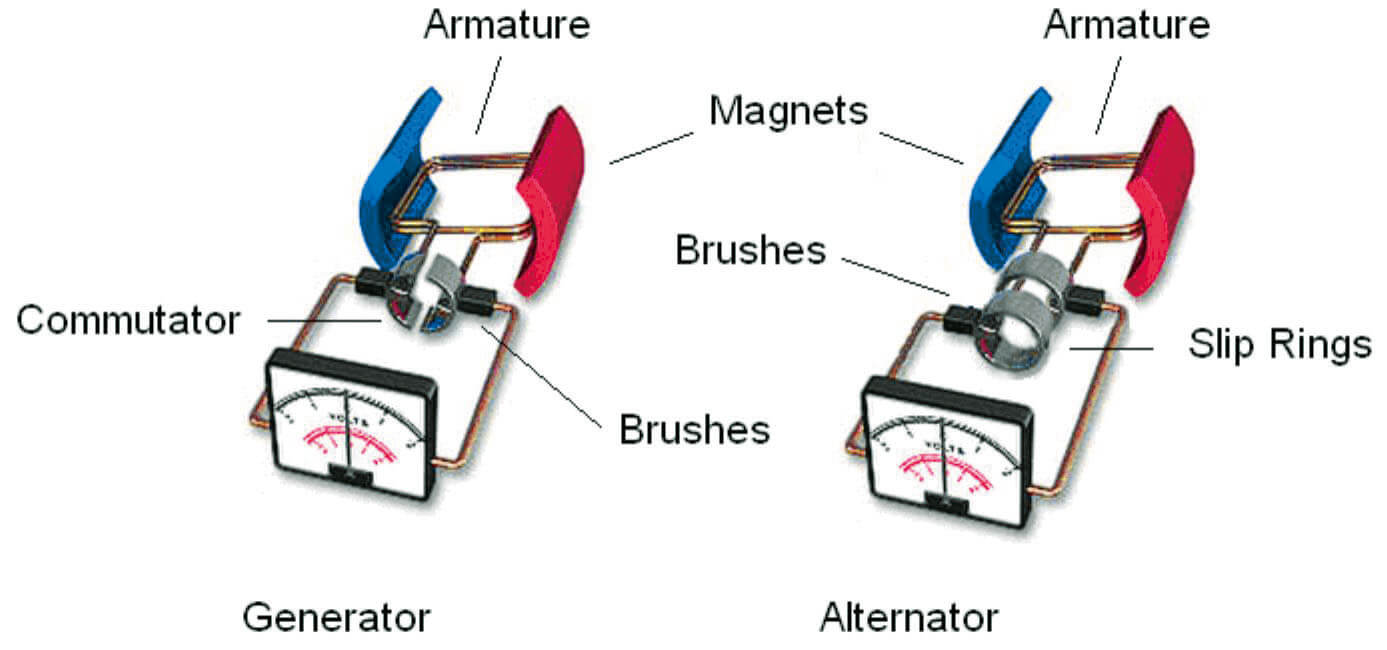28Jan 2023
table of contents

The key difference between alternator and generator is that in alternator the armature is stationary and the field system is rotating whereas in generator the armature is rotating while the magnetic field is stationary. The armature of an alternator is mounted on the stationary element called the stator, while the field winding is mounted on the rotating element. The generator connection is just the opposite.
Before we understand the difference between an alternator and a generator, let us understand what an alternator and a generator are and how they generate electricity.
Power generation is the process of using mechanical energy to create electrical energy. Electricity is generated by moving a magnet or conductor through a magnetic field, or by moving a conductor through a stationary magnetic field. Alternators and generators both use the same principle to generate electricity.
An alternator is a mechanical device that converts mechanical energy into alternating current electrical energy.
It is a generator in which a magnetic field (rotor) rotates around an armature (stator).
The magnetic field is generated by permanent magnets or electromagnets using a DC power supply. The electromagnet is located in a housing around the armature (conductor winding). The magnetic field is rotated by so-called prime movers (steam turbines, gas turbines and internal combustion engines). Its rotation causes a change in the magnetic field lines that intersect the armature conductors. As a result, a current is induced in the armature.
The armature supplies current to the output load through the brushes. Because the armature is stationary, the brushes do not wear out. Thereby increasing its mechanical life and reducing maintenance requirements.
The rotating magnetic field constantly reverses the polarity (north and south poles) it acts on the stationary armature, causing the direction of the induced current to constantly change. This is why the alternator output is always AC. This
Alternators save energy. They are enhanced and more efficient versions of generators that produce energy when it is needed (depending on the load). Therefore, the battery in the vehicle will not be drained from overcharging (because the alternator stopped supplying power). Therefore, the alternator does not waste energy.
The alternator cannot be used to charge a completely depleted battery.
Generator is a device that generates electricity by converting mechanical energy into AC or DC electrical energy.
In a generator, the housing around the armature is made of permanent magnets or stationary electromagnets called the stator. The armature consists of a coil of conductor that rotates about its axis within this fixed magnetic field. As the armature rotates, the magnetic field lines that intersect the conductor change. A current is thus induced in the rotating armature.
The armature is connected to a slip ring or commutator. They both divert current (constantly changing direction) from the rotating armature to the static output circuit. But slip rings have a full circular connection that allows the continuous transfer of electrical current from the rotating shaft, thus producing alternating current. On the other hand, there are at least 2 open circuits between the commutators, and the current direction is reversed after every half turn, so the output current maintains one direction, also known as direct current DC.
It provides constant energy even when not needed. That's why it's less efficient than an alternator. But it can generate both AC and DC, and the output voltage remains constant throughout operation. Therefore, this generator is very suitable as a backup power source for homes, offices and construction sites etc.
It can be used to charge a completely drained battery.

Although alternators and generators result in somewhat the same thing (they both provide electricity and one also provides direct current), there are actually some important technical differences between them that make each of them useful in specific applications.
| Type | Alternator | Generator |
Output current | Alternators always sense alternating current. | Generators can produce alternating current or direct current. |
Energy efficiency | Alternators are very efficient. | Generators are considered less efficient. |
Output | The output of alternator is higher than the output of generator. | Generators have a lower output compared to alternators. |
Energy conservation | Alternator only uses the energy it needs, so it saves more energy. | Generators use all the energy produced, so less energy is saved. |
Polarization after installation | In the case of an alternator no polarization is required. | Polarization is required after generator installation. |
Magnetic field | A magnetic field rotates within the stator of alternator. | In the case of a generator, the magnetic field is stationary or fixed where the armature windings rotate. |
Armature movement | The armature of alternator is stationary. | The armature of generator is spinning. |
Input power | Alternator gets its input power from the stator. | Generator gets its input power from the rotor. |
RPM (revolutions per minute) range | Alternators have a wide range of speeds. | The alternator has a very low RPM range. |
Voltage generation | Alternators only produce voltage when needed. | A generator generates voltage at any time. |
Size | Alternators are usually smaller in size. | Generators are larger and require more space to install. |
Brush efficiency | Alternator brushes last longer. | Generator brushes have a shorter service life compared to alternators. |
Charge a dead battery | Alternator never recharges a dead battery. | Generators can be used to recharge dead batteries. |
Use | Alternators are mainly used as battery charging systems in the automotive industry. | Generators are widely used to generate large-scale electricity. |
As the alternator speed decreases, the output current of the alternator decreases. Alternators reduce their efficiency when running at low speeds. As the temperature of the alternator increases, the output current will decrease. A generator is like an energy engine, converting kinetic energy into electricity. It consists of a fixed magnetic field in which a rotating electromagnet (i.e. the armature) rotates, thereby generating an electric current. Gasoline powered generators are a variation where the internal combustion engine drives a rotating shaft, which then spins an armature. Several other renewable resources, wind and water, are used as different kinds of power generators.
BISON has all the information you need about alternators and generators based on your application. If you have any questions or concerns about your alternator or generator, please do not hesitate to contact BISON generator manufacturer.
inquiry form here
BISON BLOG, All the latest news and views from Bison Machinery.